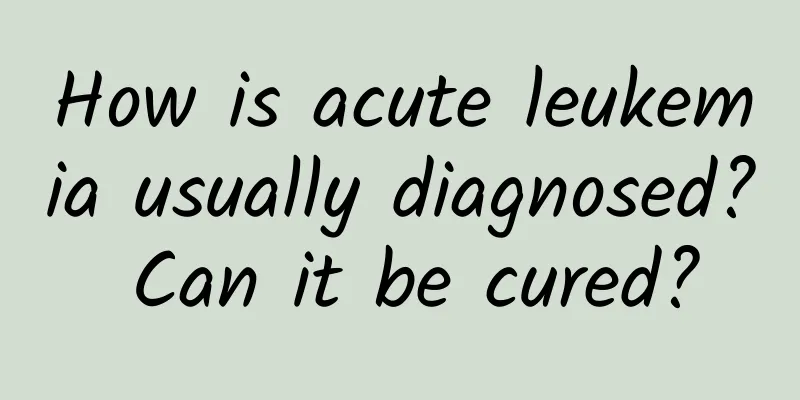How is acute leukemia usually diagnosed? Can it be cured?

|
Author: Jiang Bin, Chief Physician, Peking University People's Hospital Reviewer: Duan Yanlong, Chief Physician, Beijing Children's Hospital, Capital Medical University Leukemia is a malignant tumor of the blood system. So far, the cause of the disease is not very clear, and it may be related to radiation, viral infection, and chemical factors. In addition, the chance of getting leukemia is higher when receiving chemotherapy or radiotherapy, which is called secondary acute leukemia. There are also some drugs used, such as the drug called ethidium bromide used to treat psoriasis, which is highly carcinogenic and can also cause leukemia. Figure 1 Original copyright image, no permission to reprint Acute leukemia has a very rapid onset and may not have any prodromal symptoms. The entire occurrence and development is very rapid. In some cases, no problems are found during a physical examination one month before the onset of the disease. The time from the onset of clinical symptoms to diagnosis is relatively short. 1. What symptoms may occur for acute leukemia? Acute leukemia may cause symptoms such as fever, anemia, and bleeding. There are two main causes of fever. One is the disease itself, such as tumor fever caused by cell metabolism; the other is infectious fever caused by a decrease in white blood cells with anti-infection ability and an increase in tumor cells. Anemia is caused by the suppression of hematopoiesis. Bleeding is often caused by a decrease in platelets and abnormal coagulation. First, there may be bleeding spots on the skin, some bruises; mucosal bleeding, such as oral mucosa, gum bleeding, and nasal mucosa bleeding; visceral bleeding, such as cerebral hemorrhage, will cause corresponding symptoms of cerebral hemorrhage. If you experience the above symptoms, seek medical attention promptly. 2. What tests are needed to diagnose acute leukemia? First, a routine blood test is done to check the values of white blood cells, red blood cells, and platelets; secondly, a blood biochemistry test is done to check whether there are any abnormalities in liver and kidney functions; finally, a very critical test is done, which is a bone marrow examination. There are two types of bone marrow examinations: bone marrow puncture and bone marrow biopsy. Bone marrow puncture is to puncture the ilium, the puncture needle penetrates the periosteum, and extracts bone marrow from the bone marrow cavity; the other is to use a biopsy needle to obtain bone marrow tissue for testing. Figure 2 Original copyright image, no permission to reprint A bone marrow examination can show what the cells look like, and then perform immunophenotyping to see which antigens are on the cell surface. Based on the antigens, it can be determined whether it is myeloid leukemia or lymphocytic leukemia, and whether lymphocytic leukemia is of T-cell or B-cell origin. Finally, a chromosome test is required to see if there are any chromosomal abnormalities, and a molecular test is also required to see if there are any leukemia-related genes. Based on the above tests, it is possible to diagnose whether it is leukemia and what type of leukemia it is. At the same time, the prognosis can also be determined, whether it is low-risk, standard-risk, or high-risk, and preliminary stratification can be performed. Because acute leukemia has an acute onset and progresses quickly, most patients who come to the hospital for treatment are in serious condition. The ease of treatment is related to the white blood cell count. If the white blood cell count is very high, the prognosis is generally not very good. For low-risk patients, there is a certain cure rate with general chemotherapy, while for high-risk patients, the cure rate with chemotherapy alone is relatively low. 3. How to treat acute leukemia? Chemotherapy is the first choice for acute leukemia. The purpose of chemotherapy is to kill tumor cells and restore normal cells. Figure 3 Original copyright image, no permission to reprint The treatment of leukemia is basically divided into several steps. The first is induction therapy, which is to achieve complete remission through chemotherapy for patients with leukemia who have just been treated. After the initial chemotherapy, a bone marrow puncture is performed. If the original leukemia cells in the bone marrow are less than 5%, it is called complete remission, and hematopoiesis has basically recovered. Many people think that they are cured, but in fact, they are not. This is not called a cure. After the first stage of induction therapy, when complete remission is achieved, consolidation therapy will follow, which is intensive therapy. Stronger chemotherapy will be used to further reduce the number of tumor cells. The remaining tumor cells can then be killed by the patient's own immune system, and chemotherapy is basically no longer needed. If the doctor thinks that a hematopoietic stem cell transplant should be done, after complete remission, several courses of consolidation and intensive treatment will be carried out, and then the patient can receive a hematopoietic stem cell transplant. Immunotherapy is used to kill residual tumor cells. After achieving complete remission, chemotherapy can be used to reduce the tumor cell load, and then immunotherapy can be used to eliminate residual tumor cells. If there are too many tumor cells in the body and the load is too high, the effect of immunotherapy is limited. In general, the first step in the treatment of acute leukemia is complete remission, followed by consolidation treatment after remission. Five years without relapse after remission is called long-term survival, and ten years without relapse is called cure. In order to be cured, we must take one step at a time. The cure rate for childhood acute lymphocytic leukemia is now over 80%; for adult acute promyelocytic leukemia, after passing the most dangerous period in the early stage, the cure rate can reach over 80% in the later stage, and the treatment effect is very good. |
<<: How harmful is the terrible abdominal fat?
Recommend
There is dirt in the menstrual blood
Because if the body has corresponding gynecologic...
What is the difference between online opticianry and medical opticianry?
Many people have this misunderstanding: if they h...
An emergency? Mastering this knowledge can save lives at critical moments!
Author: Ying Jusu, Chief Nurse, Peking University...
Is it inflammation when the breast B-ultrasound shows rough edges?
If a woman feels that there is a disease problem ...
What exactly is asexuality?
Leviathan Press: According to the general definit...
How to claim unemployment insurance? What is the process of claiming unemployment insurance?
In my country, unemployed people can enjoy unempl...
Why can't I have sex when my period comes?
Why can't you have sex during menstruation? I...
Pictures of cervical erosion and hypertrophy
Women are often confused by cervical erosion. Man...
Studies have found that constipation in children can affect their intellectual development, so parents should not ignore it.
Text|The full text has 1941 words and takes about...
How long do false labor contractions last?
Uterine contractions are a common phenomenon in t...
Is it difficult to get pregnant with a cold uterus?
For women, the term "uterine cold" is n...
Are frogs animals or beneficial insects? Why do frogs appear when it rains?
Have you ever noticed that when we go out for fun...
I need to take medicine for yellow leucorrhea. Which medicine is most effective?
If a woman has yellow leucorrhea, it is definitel...
It took so much for the “new crown” vaccine to come to us...
Source: Digital Beijing Science Center...
Three essential tips for women’s health!
Maintaining good health and youthful beauty is th...









